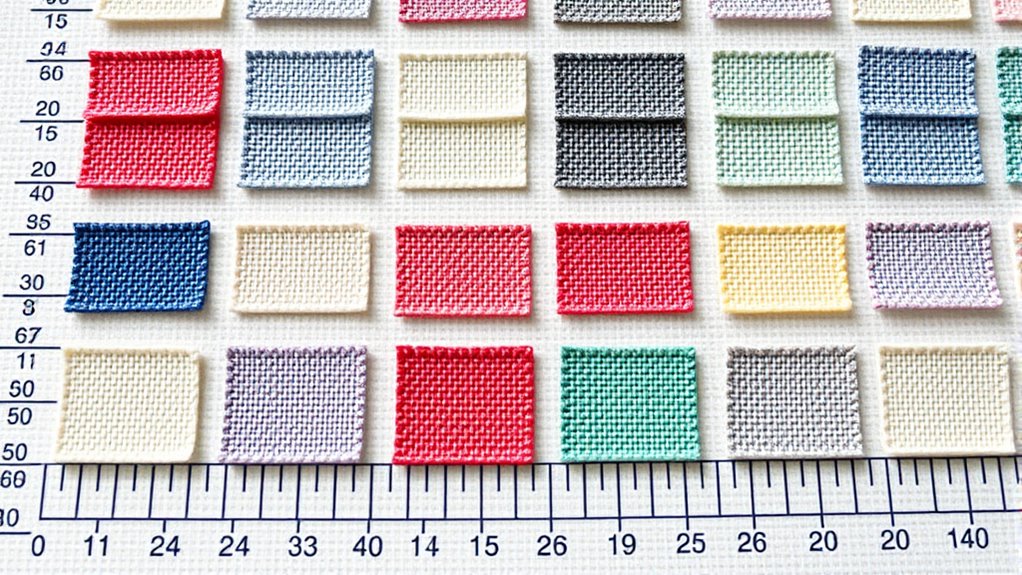A fabric shrinkage chart helps you predict how different textiles will change size after washing, so you can plan accordingly. Natural fibers like cotton and wool tend to shrink more, especially with hot water and heat, while synthetics like polyester usually stay the same. By understanding these tendencies, you can choose proper washing methods, pre-wash fabrics, and avoid surprises. Keep exploring to learn how to better use these charts for your sewing and laundry routines.
Key Takeaways
- A fabric shrinkage chart provides estimated percentage changes in size after washing to predict final garment dimensions.
- It categorizes fabrics by fiber type, showing natural fibers like cotton and wool tend to shrink more than synthetics.
- The chart helps plan pre-washing and select appropriate washing methods to maintain desired sizing.
- Understanding fabric composition on the chart guides users to avoid excessive shrinkage or distortion.
- Using the chart ensures better fit retention and reduces surprises in garment sizing post-wash.

A fabric shrinkage chart is an indispensable tool for anyone working with textiles, helping you understand how different fabrics respond to washing and drying. Knowing the typical shrinkage percentages of various materials allows you to plan your fabric care routine carefully, minimizing surprises and ensuring your garments retain their intended size and fit. Without this knowledge, you risk ending up with clothing that’s too tight or too loose, which can be frustrating and costly to fix. By referencing a shrinkage chart, you can choose appropriate washing methods, select suitable detergents, and decide whether to pre-wash fabrics before sewing or wearing.
A fabric shrinkage chart helps you plan proper care and prevent clothing from shrinking or stretching out.
Understanding fabric behavior is key to shrinkage prevention. For instance, natural fibers like cotton and wool are more prone to shrinkage than synthetic fibers such as polyester or nylon. Cotton, in particular, can shrink as much as 3-5% after the first wash if not properly handled. Wool, on the other hand, tends to felt and shrink considerably if exposed to high heat or agitation. Knowing these tendencies helps you implement the right fabric care techniques—like washing in cold water, using gentle cycles, and avoiding high heat in dryers. These steps are vital in maintaining the original size of your textiles and preventing unwanted shrinkage.
A fabric shrinkage chart also guides you in selecting pre-shrunk or blended fabrics, especially when sewing garments intended to fit precisely. If you’re making clothes or household items, you might want to pre-wash your fabric first, especially if the chart indicates a high shrinkage percentage. This preemptive step ensures that your final product won’t shrink post-construction, saving you time, effort, and potential disappointment. Additionally, understanding shrinkage helps you communicate better with suppliers or manufacturers, ensuring you order the right fabric for your project and avoid costly mistakes.
When it comes to shrinkage prevention, the chart becomes an educational resource. It highlights which fabrics need special care, such as avoiding hot water or high-heat drying, thereby protecting your investment in quality textiles. You’ll learn to read care labels more effectively and choose the appropriate washing settings. This proactive approach not only preserves the size and shape of your textiles but also extends their lifespan. Ultimately, a fabric shrinkage chart empowers you to take control of your fabric care routine, helping you maintain the appearance, fit, and durability of your clothing and household textiles.
Additionally, understanding fabric composition helps you select the most suitable cleaning methods to prevent excessive shrinkage.
Frequently Asked Questions
How Accurate Is the Shrinkage Chart for All Fabric Types?
The accuracy of a shrinkage chart varies depending on fabric blending and washing temperature. You should consider that natural fibers like cotton tend to shrink more, while synthetic blends shrink less. The chart provides a helpful guideline, but your actual results may differ based on your washing temperature and how the fabric was processed before. Always test a small piece first to better predict how your specific fabric will respond after washing.
Can I Prevent Shrinkage After Washing?
Imagine you’re wielding a time machine—proper fabric care and washing tips make all the difference. To prevent shrinkage, always check the care label, wash in cold water, and opt for gentle cycles. Avoid high heat during drying, and if possible, air dry your clothes. With these tips, you can keep your garments looking new and minimize shrinkage, ensuring your wardrobe stays stylish and well-maintained.
What Causes Uneven Fabric Shrinkage?
Uneven fabric shrinkage happens when different areas of the fabric respond differently during washing. Factors like fabric composition play a big role—natural fibers like cotton tend to shrink more unevenly than synthetic ones. Your washing methods also matter; using inconsistent water temperatures or agitation can cause uneven shrinkage. To minimize this, wash with even temperatures and gentle cycles, especially with mixed fabrics, to help maintain a uniform size.
Is Pre-Shrinking Necessary Before Sewing?
Think of sewing fabric like planting a garden—you want things to grow just right. Pre-shrinking your fabric is essential because it acts as a gardener’s pruning, preventing surprises later. Fabric pre-shrinking ensures your sewn project maintains its shape and size, saving you from warping or shrinking after washing. Considering sewing fabric considerations, it’s a smart step to keep your creations looking polished and professional, just as you’d want a well-tended garden.
How Often Should I Recheck the Shrinkage Chart?
You should recheck the fabric care and washing instructions regularly, especially if you switch between different fabric types or brands. Reassessing the shrinkage chart every few washes guarantees you stay updated on how fabrics respond to laundering. This helps you plan your sewing projects accurately, avoiding surprises. Keep an eye on changes, so your garments fit well and maintain their shape after washing.
Conclusion
By understanding fabric shrinkage, you’re like a skilled navigator charting a safe course through unpredictable waters. I once shrank a favorite shirt by forgetting to check the chart—leaving me with a tiny reminder of that lesson. Now, with this shrinkage chart, you can confidently predict how your fabrics will behave, avoiding surprises. Remember, planning ahead is your best tool—think of it as your compass guiding you toward perfectly fitting garments every time.









